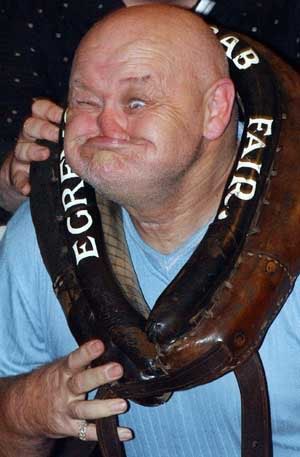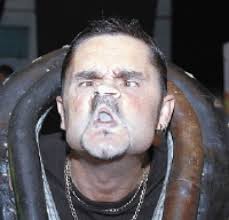 Believe it or not, there is an annual face-pulling competition that takes place in Cumbria in northern England that can trace its history back in a continuous line to the 13th century. The art of face pulling is called 'gurning'. Every year there is a competition at the annual fair in the Cumbrian town of Egremont. What is now called the gurning world championship has been held at the Egremont 'crab' fair since 1269. I have a personal connection here as as members of my family, on my mother's side, own a farm there (no jokes about how you can see the similarity from my photographs of me please!).
If one compares the faces of the gurners with cathedral gargoyles we can see similarities - I managed to make the pairings shown below. When you look at the faces of these champions, the gargoyles don't look so fantastic.
Believe it or not, there is an annual face-pulling competition that takes place in Cumbria in northern England that can trace its history back in a continuous line to the 13th century. The art of face pulling is called 'gurning'. Every year there is a competition at the annual fair in the Cumbrian town of Egremont. What is now called the gurning world championship has been held at the Egremont 'crab' fair since 1269. I have a personal connection here as as members of my family, on my mother's side, own a farm there (no jokes about how you can see the similarity from my photographs of me please!).
If one compares the faces of the gurners with cathedral gargoyles we can see similarities - I managed to make the pairings shown below. When you look at the faces of these champions, the gargoyles don't look so fantastic.
So compare the above with the gargoyle below. When I look at the medieval carvings I always think that we can be certain that the masons of the 12th century had a pretty good sense of humour!
We can compare the two below too!
Okay, I will admit I have no evidence whatsoever that there is a connection historically between between gurning and gargoyles, this is just fanciful thinking on my part....but you never know! It does raise the question however about the role of ugliness in the culture. If beauty is good, and ugliness is the absence of beauty, isn't it always bad?
Some of you may be saying, is this the Way of Beauty or the Way of Ugliness?
In fact ugliness has its place in the creation of the beautiful. It was recognised by commentators in the middle ages that beauty was a quality that could be apprehended as a good in itself. However, they recognised also, that our ability to see what is beautiful could be enhanced by contrast with ugliness. For those of us who through our fallen state might not be attracted to what is good in itself, the contrast with what is bad might illuminate it for us.
John Scotus Eriugena wrote of this principle of contrast in the 9th century: "For anything that is considered deformed in itself as part of a whole not only becomes beautiful in the totality, because it is well ordered, but is also a cause of Beauty in general; thus wisdom is illuminated by the relation to foolishness, knowledge by comparison with ignorance, which is merely imperfection and wanting, life by death, light by the opposition of shadows, worthy things by the lack of praise for them, and to be brief, all virtues only win praise by comparison with the opposite vices but without this comparison they would not be worthy of praise...As is the case with a beautiful painting, for example. For all that is ordered according to the design of divine Providence is good, beautiful and just. Indeed what could be better than the fact that the comparison of opposites lets us sing the ineffable praises of both the universe and the Creator?' De divisione naturae, V; quoted in The History of Beauty by Umberto Eco.
Now I know why beautiful people like to have me around. I flattered myself it was for other reasons, but I'm wondering now if my presence makes them look even more attractive!
For any who are interested, a modern champion describes this ancient art in the video below:
http://www.youtube.com/watch?v=9qWyMBmvNYs




